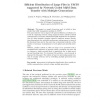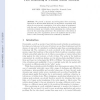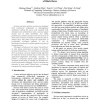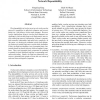AINA
2009
IEEE
14 years 2 months ago
2009
IEEE
The number of active nodes in a WSN deployment governs both the longevity of the network and the accuracy of applications using the network's data. As node hibernation techni...
AINA
2009
IEEE
14 years 2 months ago
2009
IEEE
Outlier detection in wireless sensor networks is essential to ensure data quality, secure monitoring and reliable detection of interesting and critical events. A key challenge for...
ADHOCNETS
2009
Springer
14 years 2 months ago
2009
Springer
This paper is a sequel of previous work, in which we have studied the traffic management problem in UMTS. The main objective was to improve the spectral efficiency of cellular netw...
ADHOCNETS
2009
Springer
14 years 2 months ago
2009
Springer
Abstract. As wireless sensor networks gain in popularity, many deployments are posing new challenges due to their diverse topologies and resource constraints. Previous work has sho...
AIMS
2009
Springer
14 years 2 months ago
2009
Springer
We present a dynamic and self-organized flow monitoring framework in Wireless Mesh Networks. An algorithmic mechanism that allows for an autonomic organization of the probes plane...
DSN
2009
IEEE
14 years 2 months ago
2009
IEEE
As more and more multi-tier services are developed from commercial components or heterogeneous middleware without the source code available, both developers and administrators nee...
DSN
2009
IEEE
14 years 2 months ago
2009
IEEE
The dependability of overlay services rely on the overlay network’s capabilities to effectively diagnose and recover faults (e.g., link failures, overlay node outages). However,...
EWSN
2010
Springer
14 years 2 months ago
2010
Springer
Sparse wireless sensor networks (WSNs) are being effectively used in several applications, which include transportation, urban safety, environment monitoring, and many others. Sens...
EWSN
2010
Springer
14 years 2 months ago
2010
Springer
Experimentally driven research for wireless sensor networks is invaluable to provide benchmarking and comparison of new ideas. An increasingly common tool in support of this is a t...





